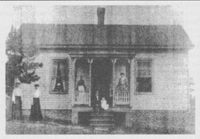
Schoolfield, established in 1903 as a textile mill village, was named for three brothers who founded Riverside Cotton Mills, later Dan River Mills. By the I 920s, this company town—complete with a school, churches, stores, a theatre, and other recreational facilities—was home to over 4,500 residents, mostly mill employees and their families, living in some 800 rental houses. A strike in 1930-31 ended a decade of employer/employee cooperation known as ‘industrial Democracy,’ yet the community’s tradition of neighborhood and family life continued to flourish. Danville annexed Schoolfield in 1951.
—Text of the Virginia Historical Marker on West Main Street at Baltimore Avenue.
Earlier this year the Danville Historical Society resolved to save from demolition a small, but important part of Schoolfield’s rich history. In August 1998, the Society forged with the City of Danville an innovative agreement to lease a cl907 mill worker’s home which stands on the western edge of Ballou Park. When fully restored, this cottage is set to become a museum to interpret the important contributions of the textile worker at Dan River Inc. It will pay tribute to hundreds of hard-working men and women who ran looms and spinning frames—powering Danville’s new industrial engine which less than a generation after Reconstruction came to vie with the supremacy of tobacco, long the cornerstone of the region’s agricultural economy.
Hundreds of houses like the one at 197 Park Circle were erected in Schoolfield, not just to shelter the workforce at the mill’s Dan River (Schoolfield) division, but also to lure new employees, attracted from farms and mountains, to Schoolfield by the promise of steady employment and the relative comfort of a well-built home. In 1903, shortly after the Dan River Power and Manufacturing Company was developed upriver and outside the city limits from the original Riverside Cotton Mills, construction on these houses began in earnest. William and James Fitzgerald, cousins of mill co-founder T.B. Fitzgerald, were responsible for some of the earliest building. By 1914, over 400 houses were completed, with rentals averaging as follows:
2-room cottage________ .75 to 1.00 per week
3-room cottage________ 1.00 to 1.25 per week
4-room cottage________ 1.25 to 1.50 per week
6-room cottage________ 2.00 to 2.25 per week
In her 1984 book, Echoes from the Mill, Nell Collins Thompson describes the progress of the village: “The first ten houses of the village, all of the four-room design, were erected on Park Avenue just beyond Ballou Park, not far from highway 29. The houses were of cottage style, each with a tin roof, chimney or chimneys for fireplace heat, and usually had stick- style railing on the front porch. Inside, each house had plastered walls, fireplaces and adequate windows for light and ventilation. Fireplaces were in the inside center corners of the house and sat “catty cornered." [The fireboxes] were arched with grates and were small, ... but effectively heated the rooms. After 191 7, electric light cords, with unshaded bulbs, hung from the center of each room.” The four-room plan of the house at 197 Park Circle allies it with these earliest dwellings—symmetrical with a gable roof, diminutive porch, and double-leaf doors opening into an angled entry adjoining the two front rooms. A shed roof covers the two back rooms and rear porch.
First known residents of the house were members of the Hopkins family, listed in the 1908 Schoolfield City Directory, part of the Danville directory that year. The family included Joseph B. Hopkins, who worked in the mill as a weaver; Miss Bettie Hopkins; and Joseph H. Hopkins, a farmer, and his wife Mary. Sometime after the First World War, the house was occupied by George and A]ma Riley, who lived at this address from the mid I 920s until about 1960 when Mr. Riley died. Prior to his retirement, Mr. Riley worked for the mill principally as a loomfixer. It was in June of 1921, just prior to the Rileys’ residence here, that the mill conveyed as a deed of gift to the City of Danville a large tract on the east side of Park Avenue which included this house. This largely undeveloped acreage that the City added to Ballou Park increased its size to the present 97 acres.
From the early 1960s until the early ‘80s, the residence was the home of Mr. Giles Hamlett, a maintenance foreman for the City of Danville, and his wife Ruth. For at least the past fifteen years the structure has been vacant except for city storage.
The restoration now in progress, spearheaded by Danville-native and renowned author, Emyl Jenkins, promises great potential as a tourist attraction for guests who come to see the Last Capital of the Confederacy’s Sutherlin Mansion and the Langhorne House, birthplace of Lady Astor and childhood home of her sister, the Gibson Girl. The Danville Historical Society believes too that the community spirit of generations of Schoolfield residents will play an important role in telling the story of the mill’s legacy in our city.